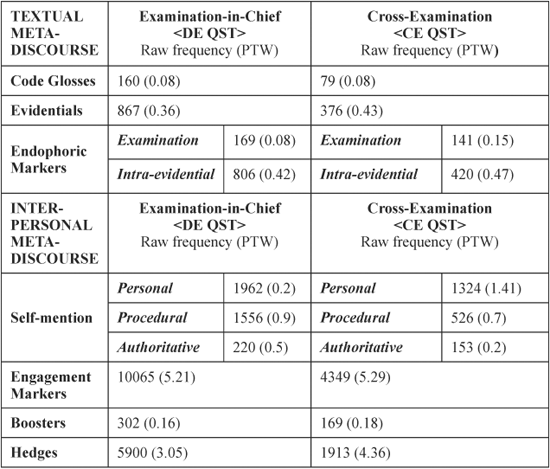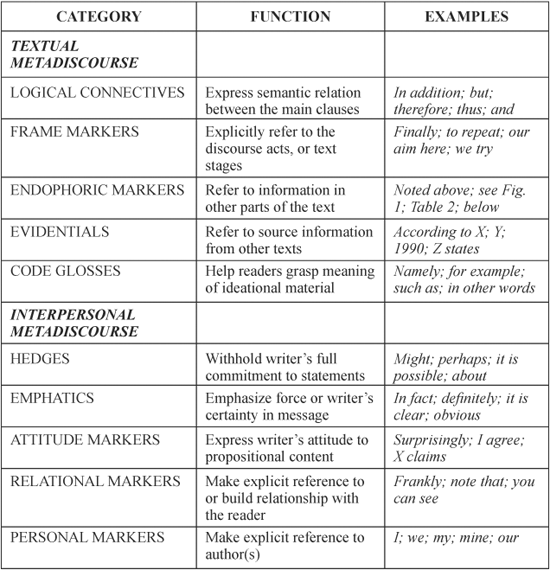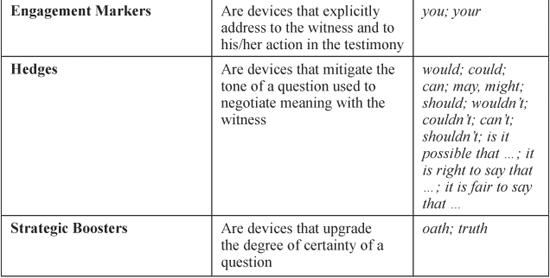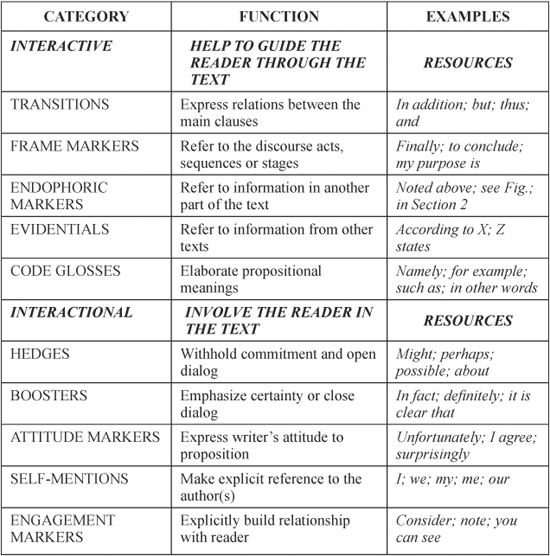The Role of Metadiscourse in Counsels’ Questions

Chapter 5
The Role of Metadiscourse in Counsels’ Questions
This chapter focuses on the role of metadiscourse in counsels’ questions during the witness examination, considering in particular the case of public inquiries in Great Britain.
The study discusses the functions ofboth textual and interpersonal metadiscourse (Hyland 1998; Hyland 2005) in the realization of lawyers’ argumentative strategies to build up effective questions in the two phases of the witness examination, namely the examination-in-chief and the cross-examination. In particular, this study aims to describe how counsels exploit the metadiscursive features to control both the form and the ideational content of the exchange (Halliday 1994) through textual metadiscourse, as well as the power relationship with the witness through interpersonal metadiscourse.
The analysis is carried out on a corpus of 15 days of witness examination transcripts (507,346 words) collected from three different public inquiries, namely the Bloody Sunday Inquiry (Northern Ireland), the Shipman Inquiry (England) and the Cullen Inquiry (Scotland), to achieve a wider perspective on common law administrative justice. It principally involves a quantitative observation of the data by means of corpus linguistics tools, and in particular by means of WordSmith Tools, which is a suite of programs for text analysis and manipulation. Moreover, the corpus is also tagged in order to create two sub-corpora: one concerning the Examination-in-Chief questions and the other concerning the Cross-Examination questions. This tagging enables us to verify any significant difference in the use of the metadiscursive elements in the two phases of the witness examination.
As regards the choice of the metadiscursive elements to be searched in the corpus, the present work has integrated Hyland’s 1998 metadiscourse classifying model to Hyland’s 2005 one, modifying them in order to meet the needs expressed by data.
The results will show that metadiscourse completes the argumentative strategy used by lawyers in order to control the witness’s narrative, giving precise means to shape both the formal and the relational sides of their questions.
Introduction
Legal discourse has been thoroughly investigated from a variety of angles over the last thirty years or so. Investigations of courtroom interaction have involved linguistic analysis of legal style and rhetoric (see Mellinkoff 1963; Goodrich 1987; Tiersma 1999), studies of specific legal genres (see Levi 1990; Bhatia 1993; Maley 1994; Gibbons 1994), as well as ethnomethodological and sociological approaches (see O’Barr 1982; Drew 1985). The analysis of courtroom discourse has recently extended to issues of language power relations and on the legal argumentative strategies employed by counsels during the examination of witnesses (see Walton 2002; Walton 2003).
From this perspective, this chapter analyzes how metadiscourse is used in counsels’ questions while examining witnesses during public inquiries in Great Britain. The chapter takes into account the role of textual and interpersonal metadiscourse (Hyland 1998; Hyland 2005) in the construction of lawyers’ argumentation in order to ask efficacious questions both in the examination-in-chief and the cross-examination. By textual metadiscourse, we mean all the linguistic devices used by the counsels to create a coherent pattern in their examination by establishing preferred interpretations of the propositional meaning produced in their questions. Indeed, textual metadiscursive features help the lawyers to form an articulate line of questioning relating individual propositions to each other as well as to other evidential resources such as written statements, documents, photographs and so on that are fundamental in the development of the testimony. On the other hand, by interpersonal metadiscourse we indicate all those elements that contribute to creating and maintaining the relationship between the legal professional and the witness, also giving the counsel’s perspective on the information brought in the examination. This category involves interactional and evaluative aspects of metadiscourse, and expresses both the lawyer’s attitude and commitment to the propositional content and to the witness. In particular, the aim of this study is to show how counsels choose certain items of metadiscourse in order to shape both the form and the ideational content of the exchange (Halliday 1994) through textual metadiscourse, as well to demonstrate their powerful position in respect to the witness through interpersonal metadiscourse.
Metadiscourse: Theoretical Background
The term metadiscourse was created and used for the first time by Zellig Harris in 1959, and indicated the ways in which the writer or the speaker conduces the receiver’s perception of a text through the use of language. Thus, metadiscourse can be seen as an “umbrella term” used to include both cohesive and interpersonal features that help to relate a particular text to its context. After this first definition, the notion has been further developed in the 1980s by Vande Kopple (1985) and Crismore (1989), who have included in their descriptions discoursal features such as hedges, connectives and various forms of text commentary to demonstrate how a writer or speaker uses their text to influence their interlocutor’s reception of it. Influencing the receiver’s perspective of a text or of an utterance is a central aspect of metadiscourse, in fact Hyland (2005) argues that metadiscourse includes all those linguistic features of the text which explicitly refer to the organization of the discourse or the writer’s stance towards either the content or the reader. As it is possible to notice, metadiscourse is a relatively new concept that has become increasingly important in the research about language.
Metadiscourse is commonly defined as “discourse about discourse or communication about communication” (Vande Kopple 1985, 83); however, as Dahl (2004) explains, it is a concept which is difficult to label because it may be realized by various linguistic forms and may realize numerous pragmatics functions in the text. For this reason, there is also a lack of clarity in the literature concerning what can be defined as metadiscourse, and there are no simple linguistic criteria for identifying it. Thus, metadiscourse can be seen as an open category (Hyland 2005, 27) to which writers/speakers are able to add new items according to the needs of the context.
Many metadiscourse studies have focused on written discourses (see, for example, Vande Kopple 1985; Crismore and Farnsworth 1990; Crismore et al. 1993; Markkanen et al. 1993; Hyland 1998; Hyland 2005; Infantidou 2005; Aedel 2005) and start from a functional perspective on language by making reference to Hallidayan Systemic Functional Linguistics, and in particular to Halliday’s distinction into three “metafunctions” or purposes of language: textual, ideational and interpersonal functions of a text (Halliday 1973). Since metadiscourse analysis involves a functional approach to texts, numerous researchers have drawn on Halliday’s “metafunctions” to build up their taxonomies of metadiscourse (for example, Crismore and Farnsworth 1990; Hyland 1998; Hyland 2005; Vande Kopple 1985). Indeed, they have distinguished metadiscourse items, categorizing them according to the functions they perform in a text, and they have individuated mainly two wider purposes of metadiscourse: (1) organizing a coherent discourse, defined as textual function; (2) creating a relationship with the audience and conveying the writer’s attitude to the text, defined as interpersonal function. The interpersonal–textual duality represents a matter of debate among researchers into metadiscourse. Mauranen (1993) has identified two strands of study into metadiscourse: (1) the integrative approach, which considers both interpersonal and textual metadiscourse; (2) the non-integrative approach, which distinguishes between metadiscourse and evaluation, considering only textual metadiscourse, which is labeled as metatext (Mauranen 1993, 1). The non-integrative model restricts metadiscourse to refer to linguistic elements “whose functions in the first place is to describe the text in which they are located” (Crismore et al. 1993, 142), while interpersonal elements are largely excluded. Since the present work draws on the integrative approach, taxonomies produced by this strand of researchers into metadiscourse will be described in the following passage of the theoretical overview.
Most studies about metadiscourse follow the integrative approach and take Vande Kopple’s (1985) classification system as their point of departure, offering their own modifications to it.
Vande Kopple divides metadiscourse into two broader categories, always following the Hallidayan functional framework:
Textual metadiscourse : the devices that principally play the role of organising the text for the reader. (“[It] shows how we link and relate individual propositions so that they form a cohesive and coherent text and how individual elements of those propositions make sense in conjunction with other elements of the text. …)”
Interpersonal metadiscourse: the items of a text that are mainly used to interact with the reader about the propositional content. (“[It] helps to express our personalities and our reactions to the propositional content of our texts and characterizes the interaction we would like to have with our readers about that content. …” (Vande Kopple 1985, 87)
Successively, Hyland (1998) follows Vande Kopple in distinguishing textual and interpersonal categories, and furthers their taxonomy of metadiscursive elements by classifying more specific functions within this macro-division. Textual metadiscourse is described by Hyland as all the devices which allow the recovery of the writer’s intention by creating a coherent and convincing text. On the other hand, interpersonal metadiscourse is defined as the linguistic means that give the author’s perspective towards both the propositional content and the readers, contributing to creating a writer–reader relationship. The taxonomy proposed by Hyland is quoted in Table 5.1 (Hyland 1998, 442).
In more recent times, Hyland (2005) furthers his analysis and proposes another model of metadiscourse always based on a functional approach, but that focuses on its contextual specificity rather than on Vande Kopple’s distinction between textual and interpersonal functions, by using Thompson and Thetela’s (1995) distinction between interactive and interactional resources to acknowledge both the organizational and the evaluative features of interaction.
The interactive dimension concerns the writer’s awareness of a participating audience. The writer’s purpose is to shape and constrain the text to meet the needs of a particular reader and at the same time to guide him or her through the text. Thus, the metadiscursive resources used in this category addresses ways of organizing discourse.
The interactional dimension concerns, on the other hand, the ways in which writers conduct the interaction by intruding and commenting on their message. The writer’s aim is to express his or her perspective and to involve readers. Metadiscourse used in this category is essentially evaluative and engaging, building up an imagined dialog with the reader.
Table 5.1 Synthesis of Hyland’s 1998 taxonomy of metadiscourse

Hyland (2005, 49) organizes these two dimensions in a model describing each metadiscursive category involved in them (see Table 5.2).
As Hyland (2005) points out, bearing in mind this distinction between the organizational and the interpersonal dimensions, it is important to notice that metadiscourse is a ubiquitous aspect in everyday language, and it constitutes one of the key features in which people communicate in different genres and settings. For this reason, studies on metadiscourse have suggested its importance in different genres, for instance in casual conversation (Schiffrin 1980), in school textbooks (Crismore 1989), in oral narratives (Norrick 2001), in postgraduate dissertations (Swales 1990) and in slogan headlines (Fuertes-Olivera et al. 2001). As a consequence, Hyland stresses the importance of considering metadiscourse integral to the context in which it is produced, and indeed, as linked to the norms and expectations of a particular cultural and professional community. By saying that effective metadiscourse is critically dependent on the rhetorical context, he proposes a “pragmatics of metadiscourse” (Hyland 1998, 439) that is strictly related to the ideas of discourse community and to the genres that develop within it. Metadiscourse becomes a valuable pattern to distinguish discourse communities and to determine the relationship among their members and the genres they produce.
Table 5.2 Synthesis of Hyland’s 2005 taxonomy of metadiscourse
This aspect has a considerable weight in this research which aims to understand the role of metadiscourse employed by lawyers to construe their own discourse in courtroom. In fact, legal professionals can be described as a discourse community, and the analysis of metadiscursive elements proves to be a valuable means to describe the persuasive way in which they communicate with witnesses during the witness examination. As highlighted by Fuertes-Olivera et al. (2001), assuming that metadiscourse is context-dependent and that it is linked to the norms and expectations of a particular setting and genre, it can be used to fulfill different pragmatic functions such as “informing” and “manipulating” that reflect the principal actions performed by counsels in their questions.
In his latest more extensive research, Hyland (2005) develops his methodological model of metadiscourse further, stressing once more its role in the creation of social engagement. He highlights the way in which these linguistic features are used as “bridge” between the writer, the audience and the text. Metadiscourse enables the writer to project him or herself in the text by signaling his or/her attitude towards both the content and the audience of the text. Indeed, language conveys information about the world, presenting it through the organization of the text itself and engaging readers in the understanding of it (interactive plane). According to Hyland, writing is interactive, in the sense that discourse features help the writer to communicate his or her text effectively to the potential audience, which is defined as “the writer’s awareness of the circumstances which define a rhetorical context and the ways that the current text is related to or aligned with other texts” (Hyland 2005, 12). Metadiscourse is therefore an important link between a text and its context. The context involves the audience, and it is possible to say that metadiscoursal resources are used by the writer to “co-produce” the text with the audience. In the same way, lawyers employ metadiscourse to create a relationship with their audience, and this is multi-layered and complex in public inquiries.
Hyland (2005) also analyzes more clearly the connection between genre, discourse community and metadiscourse. The notion of genre has proved to be a valuable tool over the last twenty years in exploring language in context and in seeing texts as social actions. The notion of discourse community completes the concept of genre, being the source of it, and conveys the idea that people normally use language to communicate with individuals that are members of the same social group (Hyland 2005, 139). As a consequence, being part of a discourse community involves a number of contextual factors that are relevant to the production and interpretation of spoken and written texts. According to Hyland, the definition of a discourse community offers an understanding of how meaning is produced in interaction and to observe metadiscourse as socially situated. As regards this last point, he focuses in particular on disciplinary communities and on the norms that individuals need to acquire in order to get competence in a specialized language. Hyland argues that the choice of the metadiscourse strategies is strictly linked to the shared knowledge of a particular discourse community, and indeed, to understand its pragmatic use, metadiscourse must be observed in the genres and communities which give it meaning (Hyland 2005, 143). Metadiscourse thus offers a framework for understanding communication as social engagement, as it signals the attitude towards the content and the audience of a text. The present work focuses on this perspective, and intends to analyze how metadiscourse is used by lawyers as an argumentative strategy to build up effective questions in courtroom.
As evidenced by the literature review of metadiscourse studies above, the majority of the research in this field has focused on written discourses, and only few have analyzed oral discourses (for example, Schiffrin 1980; Norrick 2001; Swales 2001). Moreover, the literature has highlighted a gap in the studies about the use of metadiscourse in the courtroom setting, and for this reason, the present research would like to broaden the scope of analysis by describing the metadiscursive features of the lawyer…witness interaction during the oral genre witness examination.
The Corpus
The analysis is carried out on a corpus of witness examination transcripts collected from the official websites of three public inquiries established in England, Scotland, and Northern Ireland:
1. the Cullen Inquiry, concerning the “Dunblane massacre,” a multiple homicide committed in a primary school at Dunblane, Scotland on March 13, 1996, chaired by Lord Douglas Cullen;
2. the Bloody Sunday Inquiry, dealing with the killing of civilians due to a shooting caused by British soldiers during a peaceful march in Derry, Northern Ireland on January 30, 1972, chaired by Lord Saville of Newdigate;
3. the Shipman Inquiry, concerning the homicide of 15 patients carried out by Dr. Harold Shipman at Market Street, Hyde, near Manchester, England, chaired by Dame Janet Smith.
Specifically, the corpus is composed of five days of transcripts for each public inquiry, giving a total of 507,346 tokens. As the main interest of this chapter concerns the questions posed by the lawyers, both during Examination-in-Chief and Cross-Examination, the corpus has subsequently been tagged by means of the software Note Tab Light, which enables the user to select by hand parts of text that can be used separately in a quantitative analysis. Three tags have been chosen to identify three smaller sub-corpora concerning questions:
a. <QST> (Question), including all the questions posed by the lawyers and by the chair of the inquiry;
b. <DE QST> (Direct Examination Question), including the questions posed during Examination-in-Chief;
c. <CE QST> (Cross-Examination Question), including all the questions posed during Cross-Examination.
This type of tagging allows the subdivision into sub-corpora, and at the same time, leaves all the data available in their entire form for a more complete analysis.
Methods
The analysis principally involved a quantitative observation of the data by means of corpus linguistics tools, and in particular by means of WordSmith Tools , a suite of programs for text analysis and manipulation. WordSmith Tools enables the user to identify and study patterns of lexis in texts which are not easily found otherwise.
As regards the choice of the metadiscursive elements to be researched in the corpus, the present study has integrated Hyland’s 1998 model to Hyland’s 2005 one, considering both the textual and the interpersonal dimensions.
After having defined these preliminary categories, as a first step we focused on the wordlists of the sub-corpora <DE QST> and <CE QST> to determine the most frequent metadiscursive resources in them. We also checked two-word, three-word and four-word clusters wordlists in order to identify composed items such as code glosses that are usually two-, three- or even four-word expressions (for example, in other words) that cannot be not be detected by a simple wordlist.
The second step regarded the investigation of the keywords of the sub-corpora, and we observed the keyness of the metadiscursive elements in the corpus to verify their saliency in the Examination-in-Chief sub-corpus as well as in the Cross-Examination one. In order to find out keyness, at first each sub-corpus wordlist was compared to the BNC Spoken List. The choice of this reference corpus was determined by the nature of the data, which are transcriptions of oral exchanges between counsels and witnesses. Moreover, we also made keywordlists within the corpus itself by comparing each sub-corpus wordlist with the other (the <CE QST> List versus <DE QST> List) to identify peculiarities in the use of the metadiscursive elements due to the different phase of the examination. Looking at the three keywordlists obtained, we detected the most significant items for each category mentioned above, and we also chose other metadiscursive resources typical of the public inquiry witness examination (for example, Tribunal, Inquiry, statement, paragraph, photograph) that needed to be studied in detail through the observation of their phraseology.
After this preliminary analysis of frequency and keyness, we decided to modify our first classification that integrated Hyland taxonomies by adding some sub-categories and by leaving aside some others in order to meet the needs expressed by the data. The new scheme conceived is set out in Table 5.3.
The third step of the analysis concerned the phraseology of the items selected for their frequency and keyness. To investigate the phraseology of each metadiscursive element, Wordsmith’s Concordance Analysis was used. This function of Wordsmith’s Tools allows us to study a keyword in context in order to find recurrent clusters in a corpus. Thus, this step of the analysis consisted of the observation of the concordance lines of every item in both sub-corpora in order to discover the most frequent clusters. The data have been analyzed considering first clusters of three words and then clusters of four words to determine the more significant collocations.
Table 5.3 Re-elaborated taxonomy of metadiscourse after the preliminary quantitative analysis of the sub-corpora


After having determined the most frequent collocation patterns for each textual and interpersonal piece of metadiscourse, we have tried to relate these clusters to the functions they fulfill in <DE QST> and <CE QST>.
Results
Textual Metadiscourse
This section will present the results concerning textual metadiscourse. The linguistic devices analyzed here allow the lawyer to shape and constrain his or her questions to meet the needs of the courtroom setting, and at the same time to produce precise rhetorical strategies. The use of resources in this category enables the legal professional to organize the discourse during the examination in order to convey the propositional information in a coherent and convincing way.
Code glosses Code glosses are textual devices that “supply additional information by rephrasing, explaining or elaborating what has been said, to ensure the reader to recover the writer’s intended meaning” (Hyland 2005, 52). In the lawyer’s questions, they function as reformulation markers and serve the legal professional to introduce a rephrasing either of his or her request (self-reformulation) or of the witness’s answer (other-reformulation).
To begin with, it was decided to start the research of code glosses in the corpus by examining the wordlists from simple words to four-word clusters both for the Examination-in-Chief sub-corpus and for the Cross-Examination sub-corpus, keeping as a reference the examples provided by Hyland in his taxonomy (Hyland 2005, 52). The choice of checking the two-word, three-word and four-word cluster wordlists was driven by the fact that code glosses are in most of the cases two-, three- or even four-word expressions, so not detectable in a simple wordlist. After browsing the frequency lists, it was discovered that the presence of code glosses in the two sub-corpora is limited, and frequency is low in terms of their raw frequency and their number of occurrences per thousand words that goes from a minimum of 0.01% to a maximum of 0.03%, as demonstrated in Table 5.4.
Even though the frequency of code glosses is very low in the sub-corpora, it is possible to notice a higher occurrence of these metadiscursive items in the examination-in-chief, in which the search for information as complete as possible is the main purpose.
Starting from which is , the most frequent code gloss in the two sub-corpora, it is possible to notice that it occurs 64 times in the <DE QST> sub-corpus (0.03%) and 30 in the <CE QST> sub-corpus (0.03%). The analysis of the most frequent contexts of this item highlighted that which is can fulfill two main functions in both sub-corpora, as shown in Table 5.5.
As highlighted by Table 5.5, which is can function both as a restrictive and as an expansive code gloss. It is mainly used by legal professionals during the whole examination to guide the witness through the evidence determining his or her preferred pattern of understanding. In both cases, the main purpose of which is is to introduce a specification that makes the evidence in the question as clear as possible in order to avoid any ambiguity that could mislead the search for information.
Table 5.4 Code glosses frequency in the sub-corpora

